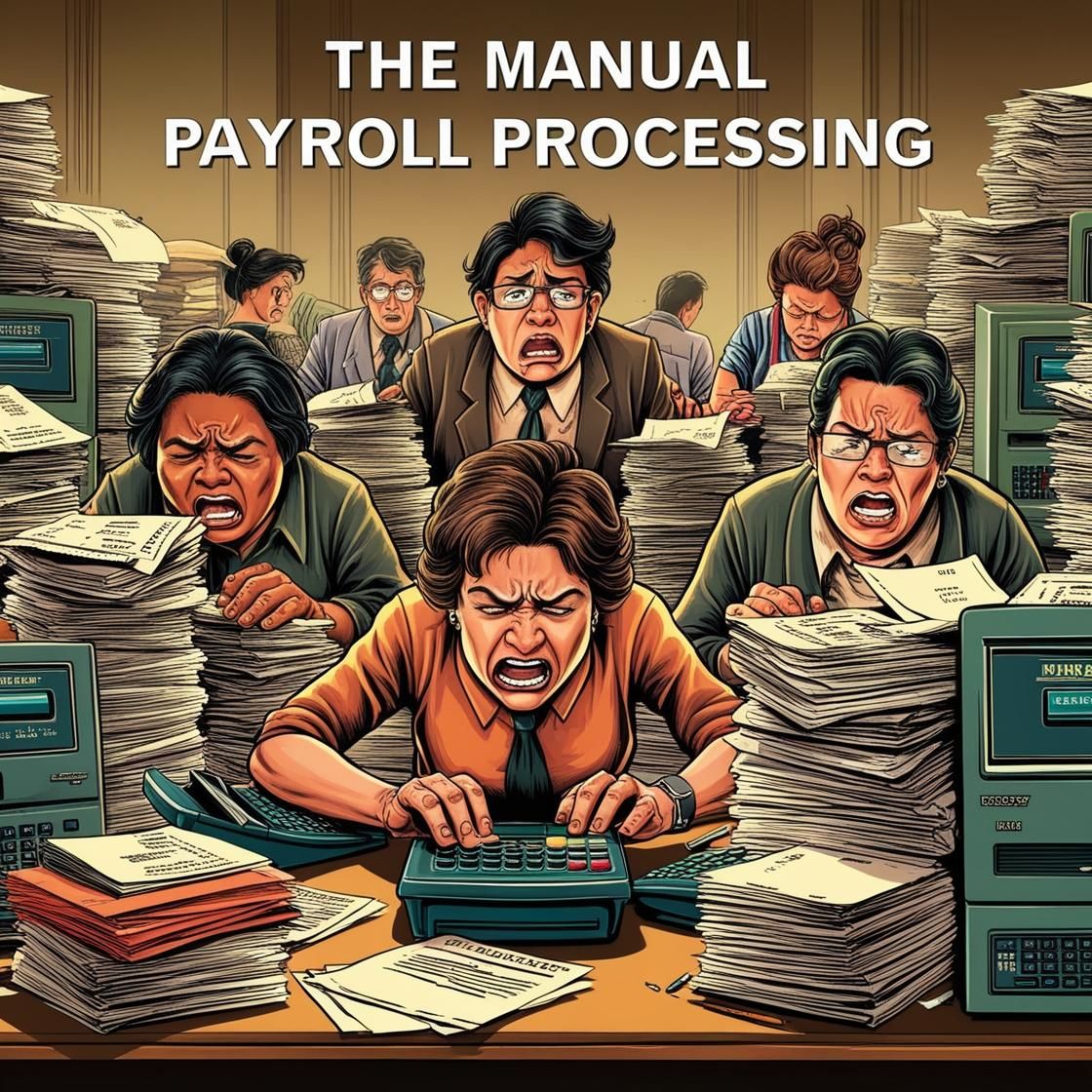In today’s fast-paced business environment, relying on manual payroll processes is like using outdated technology—slow, inefficient, and prone to errors. While it may have been the norm in the past, manual payroll is no longer viable for businesses of any size. In this article, we will explore the challenges of manual payroll, the risks involved, and why automated payroll solutions offer a much better alternative.
What Is Manual Payroll?
Manual payroll refers to the process of calculating and distributing employee wages without the use of specialized payroll software. In a manual system, human resources or accounting staff are responsible for performing every step, from calculating regular hours and overtime pay to managing various deductions and generating paychecks or direct deposits.
While basic accounting software or spreadsheets may assist with calculations, these tools still require significant manual input and validation, increasing the likelihood of mistakes and inefficiencies.
For any assistance in
HRMS, Payroll & Compliance Outsourcing, Tax Management or S&E Registration, do contact us.
We provide PAN India service.
Click here to get the Lowest QuotesCommon Challenges of Manual Payroll Processing in India
1. Human Error Risk
One of the biggest risks of manual payroll is the potential for human error. Since the process relies heavily on data entry and calculations by individuals, mistakes are bound to happen. Common errors include:
- Data Entry Mistakes: Simple errors such as mistyped numbers, missing hours, or incorrect pay rates can cause significant payroll discrepancies. For example, entering 30 hours instead of 40 can lead to underpayment, while small decimal mistakes can drastically alter an employee’s earnings.
- Miscalculations: Payroll calculations can be complex, especially when factoring in various pay rates, overtime, tax deductions, and other withholdings. A single miscalculation can lead to overpayment or underpayment, both of which create their own set of problems.
2. Keeping Up with Regulations
The world of payroll is constantly changing. New tax laws, shifts in the minimum wage, and updates to leave policies can be overwhelming for businesses that still use manual systems. Payroll departments are responsible for ensuring compliance, and manually keeping up with these updates is a time-consuming and often frustrating task.
- Compliance Challenges: Errors in staying current with evolving tax codes and labor laws can lead to non-compliance, which could result in costly fines, legal issues, or damage to a company’s reputation.
- Cost of Non-Compliance: Failing to meet legal requirements can lead to significant financial penalties, legal fees, and potential lawsuits. In many cases, these costs far outweigh the savings of using a manual payroll system.
3. Inefficient Time Tracking
Accurate time tracking is crucial for payroll, but manual methods like paper timesheets or punch cards are prone to inefficiencies and mistakes. Common problems include:
- Inaccurate Tracking: Employees may forget to clock in or out, record overtime inaccurately, or make other errors that result in incorrect pay. This forces payroll staff to spend additional time resolving discrepancies.
- Leave Management Issues: Managing paid time off (PTO), sick leave, or vacation days manually can be complex and prone to mistakes. Without an automated system to track leave balances, it’s easy to miss key updates or make errors, which can lead to dissatisfaction among employees.
4. Reduced Employee Productivity and Morale
Manual payroll processing not only affects the HR or payroll department but can also impact employee morale. Employees may feel frustrated if their paychecks are incorrect or delayed due to the challenges of manual payroll processing. Additionally, payroll staff members are burdened with repetitive tasks, which can lead to burnout.
- Time-Consuming Data Entry: Payroll staff must manually enter hours worked, deductions, and benefits, which can be tedious and time-consuming. This often detracts from their ability to focus on more strategic tasks, affecting overall productivity.
- Employee Frustration: Employees who experience payroll errors, whether it’s being underpaid or overpaid, may feel undervalued or distrustful of the company. Discrepancies in pay can lead to resentment, reduced morale, and higher turnover.
5. Security Risks
Manual payroll systems often store sensitive personal and financial information, such as employee social security numbers and bank account details, either on paper or in unsecured spreadsheets. These methods expose the company to several security risks:
- Data Breaches: Paper files or spreadsheets are vulnerable to theft, loss, or unauthorized access, which could compromise employee data. In a world where cybercrime is on the rise, manual payroll increases the risk of a data breach.
- Loss of Documents: Physical payroll records are prone to misplacement, damage, or theft, putting sensitive information in jeopardy.
6. Impact on Company Operations
Payroll is a critical part of business operations, and any disruption or inaccuracy can lead to significant issues within the company. Manual payroll errors can affect the bottom line and operational efficiency.
- Operational Disruptions: Reconciling errors, handling discrepancies, and communicating with employees about payroll issues can take valuable time away from more pressing business tasks. This reduces the overall efficiency of HR departments and can slow down the company’s operations.
- Legal and Financial Consequences: Payroll errors can have legal ramifications, especially if they result in wage theft claims, tax issues, or fines for non-compliance. Inaccurate deductions or tax reporting can expose the business to costly audits and legal challenges.
Why Manual Payroll Is Inefficient
Manual payroll is not only outdated, but it is also inefficient. The challenges discussed above are just a few of the common problems businesses face when relying on manual systems. The need for accuracy, compliance, and security in payroll is crucial, and these cannot be guaranteed when human involvement is so high.
The Benefits of Automated Payroll Solutions
Given the challenges outlined, businesses should consider transitioning to automated payroll systems. Automated solutions eliminate most of the issues associated with manual processes, including:
- Accuracy: Automated systems reduce the risk of errors by performing calculations automatically, ensuring precise pay and deductions.
- Time Savings: Payroll can be processed quickly and efficiently, freeing up HR and payroll staff to focus on more strategic tasks.
- Compliance: Automation helps businesses stay up-to-date with changing tax laws and regulations, ensuring compliance and reducing the risk of fines or legal issues.
- Security: Cloud-based payroll systems store sensitive data securely, reducing the risk of breaches and ensuring that employee information is protected.
- Employee Satisfaction: Automated systems ensure employees are paid accurately and on time, which boosts morale and productivity.
Conclusion
Manual payroll is a cumbersome, error-prone, and inefficient process that can have serious consequences for businesses. From the risk of human error to compliance challenges and security vulnerabilities, the drawbacks of manual payroll are clear. Automating payroll not only solves these issues but also saves time, reduces risk, and improves employee satisfaction. For businesses looking to streamline operations and stay competitive, transitioning to an automated payroll system is a smart move.
For any assistance in
HRMS, Payroll & Compliance Outsourcing, Tax Management or S&E Registration, do contact us.
We provide PAN India service.
Click here to get the Lowest Quotes




